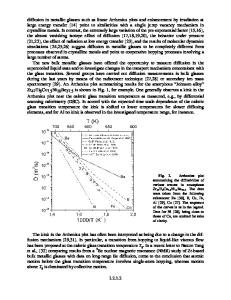Strategies to tailor serrated flows in metallic glasses
- PDF / 1,591,910 Bytes
- 13 Pages / 584.957 x 782.986 pts Page_size
- 100 Downloads / 873 Views
PLASTICITY AND FRACTURE AT THE NANOSCALES
Strategies to tailor serrated flows in metallic glasses Zhe Fan1,a)
, Qiang Li1, Cuncai Fan1, Haiyan Wang1, Xinghang Zhang1,b)
1
School of Materials Engineering, Purdue University, West Lafayette, Indiana 47907, USA Address all correspondence to these authors. e-mail: [email protected] b) e-mail: [email protected] a)
Received: 17 July 2018; accepted: 5 November 2018
Serrated flow is one important characteristic of shear bands through which metallic glasses (MGs) accommodate plastic deformation. Serrated flow can be affected by intrinsic properties such as elastic modulus or extrinsic variables such as strain rate. However, the influences of pre-deformation and interfaces on serrated flow are less well understood. In this study, by using in situ micropillar compression inside a scanning electron microscope, we show that pre-deformation (consisting of cyclic loading/unloading below the nominal elastic limit) suppresses serrated flows in amorphous-CuNb but enhances serrated flows in amorphous-CuZr at both high and low strain rates. Moreover, layer interfaces in Cu/amorphous-CuNb multilayers mitigate serrated flows, and the average stress drop and strain duration associated with shear banding process can be tailored. Strain accommodation and energy dissipation via shear banding have clear impact on serrated flows. This study provides new perspectives on tailoring serrated flows and enhancing plastic deformation of MGs.
Introduction Metallic glasses (MGs) are promising structural materials due to their attractive properties, such as high yield strength, large elastic limit, and excellent wear resistance [1, 2, 3, 4]. Unlike dislocation-mediated plasticity of crystalline materials, plastic deformation of MGs is accommodated by shear banding, but subsequent rapid propagation of shear bands and strain localization lead to limited plasticity at room temperature [5, 6, 7]. Successful control of shear banding could enhance the plasticity of MGs [8, 9, 10]. At atomic scale, free volume model [11] and shear transformation zone (STZ) model [12, 13, 14] can be used to explain the deformation of MGs. Both models show that shear banding leads to softening due to shear dilation or structural disorder. Without barriers like nanocrystals or interfaces, shear bands cannot be diverted or arrested, but intermittent shear banding process is still observed in the form of pop-in events under nanoindentation [15, 16, 17] and serrated flows on the stress–strain curves under compression [18, 19, 20, 21, 22]. Serrated flows reveal the dynamic properties of shear bands, and the underlying physics and mechanisms of serrated flows have been a subject of significant interest. Cheng et al. [23] demonstrated that shear banding can be “cold” in a stop-and-go manner (serrated) or “hot” in a catastrophic manner (non-serrated)
ª Materials Research Society 2019
affected by the heat generated in shear bands. Sun et al. [24] showed that serrated flows with a power law distribution can be observed in ductile MGs and exp
Data Loading...











